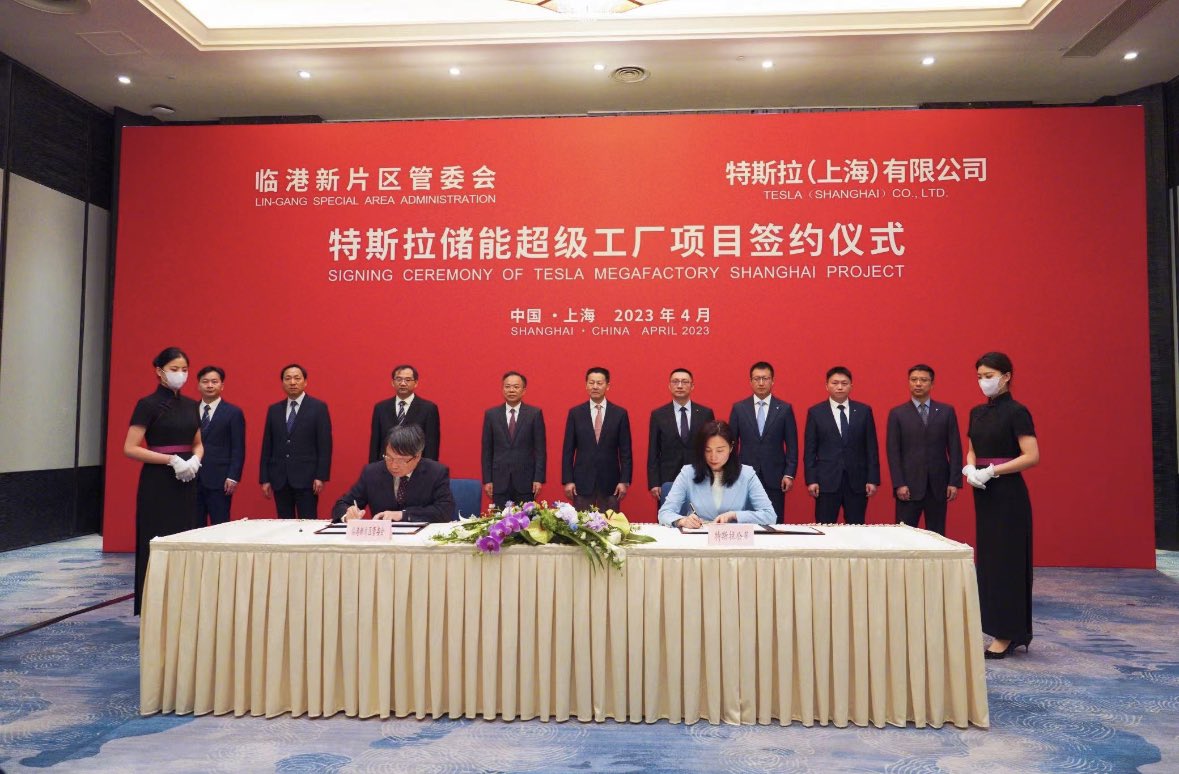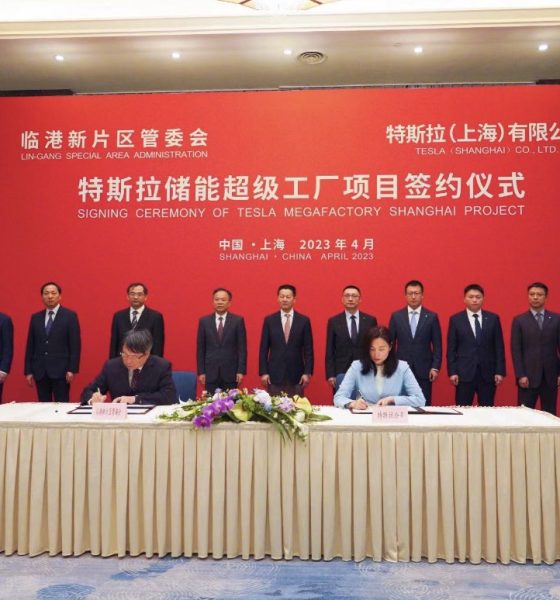

News
Tesla announces new Megafactory in Shanghai that can produce 10K Megapacks per year
Tesla is set to expand its energy storage business in China by constructing a new Megafactory in Shanghai’s Lingang area. The facility will effectively bring Tesla’s flagship battery storage product to the world’s largest electric vehicle market.
As confirmed by the EV maker on its official social media accounts, Tesla signed an agreement on April 9 with Shanghai’s Lingang special area administration to build a Megafactory in the area. The facility marks Tesla’s first foray into energy storage production outside the United States.
Construction of the facility is expected to start in Q3 2023, with production slated to begin in Q2 2024. The facility is planned to have an initial production capacity of 10,000 units per year, or almost 40 GWh worth of energy storage. Megapacks produced at the Shanghai Megafactory are expected to be supplied to global markets.
In line with the upcoming energy storage project, Tesla opened a job listing for a Megapack project manager position in Shanghai last month. CEO Elon Musk, for his part, noted on Twitter that the new facility would supplement the output of Tesla’s first Megafactory in Lathrop, California.
Tesla opening Megapack factory in Shanghai to supplement output of Megapack factory in California https://t.co/hDpqoyNeOx
— Elon Musk (@elonmusk) April 9, 2023
Tesla’s Gigafactory Shanghai, which produces the Model 3 sedan and Model Y crossover, is also located in the Lingang area of Shanghai’s Pudong new district. The facility began operations in 2019 and has since become Tesla’s largest global EV production site by volume. The facility also serves as the company’s primary vehicle export hub.
The Megapack is an advanced battery system designed for large-scale energy projects. As per Tesla’s official webpage for the flagship battery system, each Megapack can store over 3 MWh of energy, which is enough to power about 3,600 homes for an hour. In the United States, the Megapack is listed with a price of $1,879,840 for a 2-hour unit without installation in California. With installation, the price of a similarly-specced battery is listed at $2,669,050.
Tesla’s Megapack batteries seem to have captured a lot of interest. On its order page on Tesla’s official website, the earliest desired delivery date for the Megapack is currently listed for Q1 2025.
Deputy Secretary General of the Shanghai municipal government, Zhuang Mudi, stated that Tesla’s Giga Shanghai project five years ago captured global attention, and it helped establish Shanghai as a key player in the development of the new energy vehicle industry. The official expressed optimism that Tesla’s Megafactory would have a similar impact.
“We are witnessing the signing of the Tesla Megafactory project today, which will be an important force in promoting the development of Shanghai’s new energy storage industry and green low-carbon transformation,” Zhuang said.
Don’t hesitate to contact us with news tips. Just send a message to simon@teslarati.com to give us a heads up.

News
Tesla FSD fleet is nearing 7 billion total miles, including 2.5 billion city miles
As can be seen on Tesla’s official FSD webpage, vehicles equipped with the system have now navigated over 6.99 billion miles.

Tesla’s Full Self-Driving (Supervised) fleet is closing in on almost 7 billion total miles driven, as per data posted by the company on its official FSD webpage.
These figures hint at the massive scale of data fueling Tesla’s rapid FSD improvements, which have been quite notable as of late.
FSD mileage milestones
As can be seen on Tesla’s official FSD webpage, vehicles equipped with the system have now navigated over 6.99 billion miles. Tesla owner and avid FSD tester Whole Mars Catalog also shared a screenshot indicating that from the nearly 7 billion miles traveled by the FSD fleet, more than 2.5 billion miles were driven inside cities.
City miles are particularly valuable for complex urban scenarios like unprotected turns, pedestrian interactions, and traffic lights. This is also the difference-maker for FSD, as only complex solutions, such as Waymo’s self-driving taxis, operate similarly on inner-city streets. And even then, incidents such as the San Francisco blackouts have proven challenging for sensor-rich vehicles like Waymos.
Tesla’s data edge
Tesla has a number of advantages in the autonomous vehicle sector, one of which is the size of its fleet and the number of vehicles training FSD on real-world roads. Tesla’s nearly 7 billion FSD miles then allow the company to roll out updates that make its vehicles behave like they are being driven by experienced drivers, even if they are operating on their own.
So notable are Tesla’s improvements to FSD that NVIDIA Director of Robotics Jim Fan, after experiencing FSD v14, noted that the system is the first AI that passes what he described as a “Physical Turing Test.”
“Despite knowing exactly how robot learning works, I still find it magical watching the steering wheel turn by itself. First it feels surreal, next it becomes routine. Then, like the smartphone, taking it away actively hurts. This is how humanity gets rewired and glued to god-like technologies,” Fan wrote in a post on X.
News
Tesla starts showing how FSD will change lives in Europe
Local officials tested the system on narrow country roads and were impressed by FSD’s smooth, human-like driving, with some calling the service a game-changer for everyday life in areas that are far from urban centers.

Tesla has launched Europe’s first public shuttle service using Full Self-Driving (Supervised) in the rural Eifelkreis Bitburg-Prüm region of Germany, demonstrating how the technology can restore independence and mobility for people who struggle with limited transport options.
Local officials tested the system on narrow country roads and were impressed by FSD’s smooth, human-like driving, with some calling the service a game-changer for everyday life in areas that are far from urban centers.
Officials see real impact on rural residents
Arzfeld Mayor Johannes Kuhl and District Administrator Andreas Kruppert personally tested the Tesla shuttle service. This allowed them to see just how well FSD navigated winding lanes and rural roads confidently. Kruppert said, “Autonomous driving sounds like science fiction to many, but we simply see here that it works totally well in rural regions too.” Kuhl, for his part, also noted that FSD “feels like a very experienced driver.”
The pilot complements the area’s “Citizen Bus” program, which provides on-demand rides for elderly residents who can no longer drive themselves. Tesla Europe shared a video of a demonstration of the service, highlighting how FSD gives people their freedom back, even in places where public transport is not as prevalent.
What the Ministry for Economic Affairs and Transport says
Rhineland-Palatinate’s Minister Daniela Schmitt supported the project, praising the collaboration that made this “first of its kind in Europe” possible. As per the ministry, the rural rollout for the service shows FSD’s potential beyond major cities, and it delivers tangible benefits like grocery runs, doctor visits, and social connections for isolated residents.
“Reliable and flexible mobility is especially vital in rural areas. With the launch of a shuttle service using self-driving vehicles (FSD supervised) by Tesla in the Eifelkreis Bitburg-Prüm, an innovative pilot project is now getting underway that complements local community bus services. It is the first project of its kind in Europe.
“The result is a real gain for rural mobility: greater accessibility, more flexibility and tangible benefits for everyday life. A strong signal for innovation, cooperation and future-oriented mobility beyond urban centers,” the ministry wrote in a LinkedIn post.
News
Tesla China quietly posts Robotaxi-related job listing
Tesla China is currently seeking a Low Voltage Electrical Engineer to work on circuit board design for the company’s autonomous vehicles.

Tesla has posted a new job listing in Shanghai explicitly tied to its Robotaxi program, fueling speculation that the company is preparing to launch its dedicated autonomous ride-hailing service in China.
As noted in the listing, Tesla China is currently seeking a Low Voltage Electrical Engineer to work on circuit board design for the company’s autonomous vehicles.
Robotaxi-specific role
The listing, which was shared on social media platform X by industry watcher @tslaming, suggested that Tesla China is looking to fill the role urgently. The job listing itself specifically mentions that the person hired for the role will be working on the Low Voltage Hardware team, which would design the circuit boards that would serve as the nervous system of the Robotaxi.
Key tasks for the role, as indicated in the job listing, include collaboration with PCB layout, firmware, mechanical, program management, and validation teams, among other responsibilities. The role is based in Shanghai.
China Robotaxi launch
China represents a massive potential market for robotaxis, with its dense urban centers and supportive policies in select cities. Tesla has limited permission to roll out FSD in the country, though despite this, its vehicles have been hailed as among the best in the market when it comes to autonomous features. So far, at least, it appears that China supports Tesla’s FSD and Robotaxi rollout.
This was hinted at in November, when Tesla brought the Cybercab to the 8th China International Import Expo (CIIE) in Shanghai, marking the first time that the autonomous two-seater was brought to the Asia-Pacific region. The vehicle, despite not having a release date in China, received a significant amount of interest among the event’s attendees.








